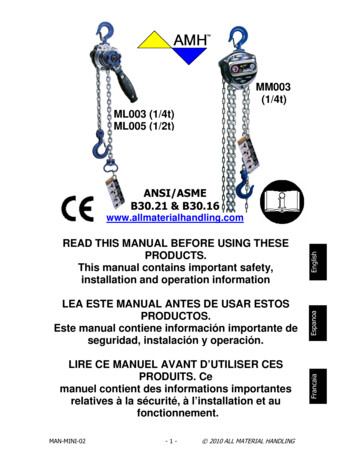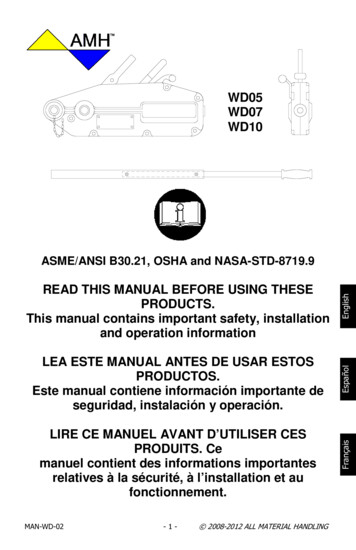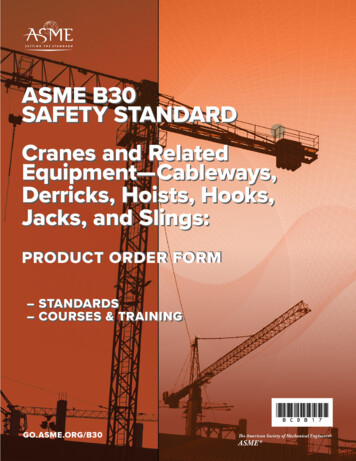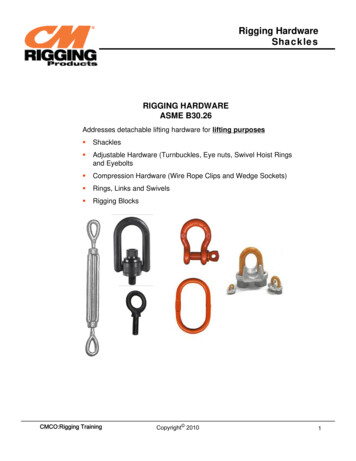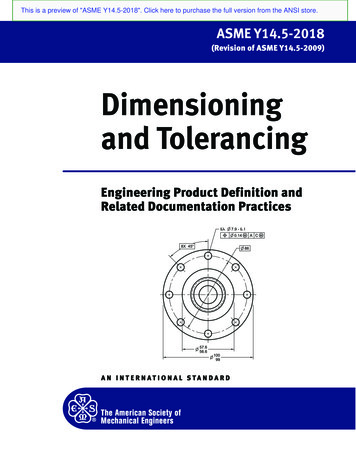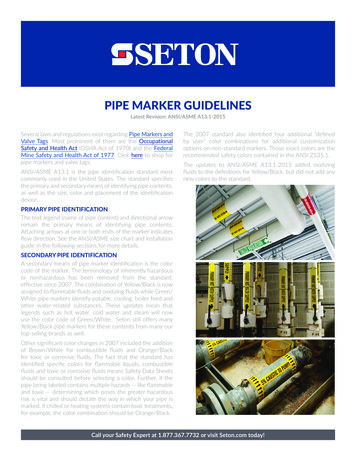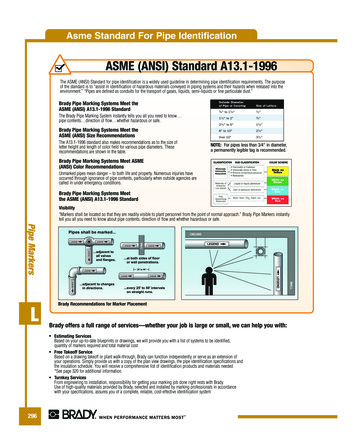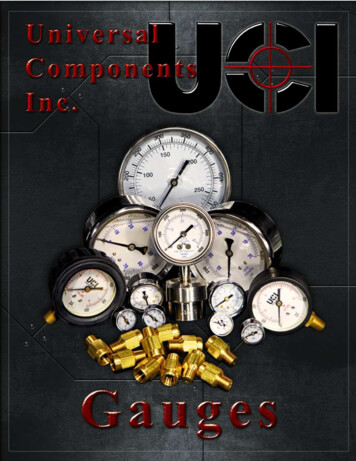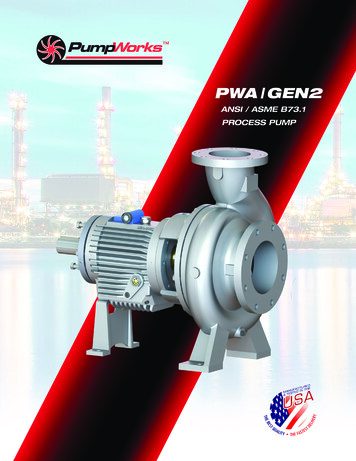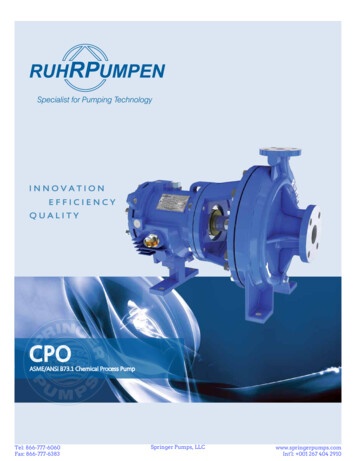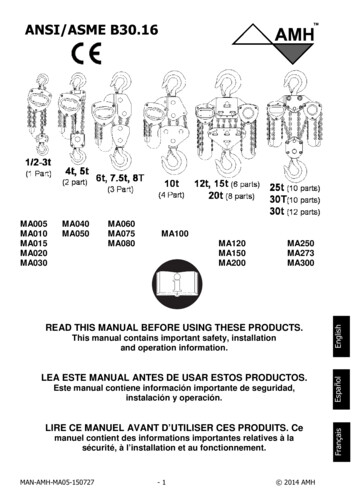
Transcription
ANSI/ASME B30.16MA100MA120MA150MA200MA250MA273MA300READ THIS MANUAL BEFORE USING THESE PRODUCTS.This manual contains important safety, installationand operation information.LEA ESTE MANUAL ANTES DE USAR ESTOS PRODUCTOS.Este manual contiene información importante de seguridad,instalación y operación.LIRE CE MANUEL AVANT D’UTILISER CES PRODUITS. Cemanuel contient des informations importantes relatives à lasécurité, à l’installation et au fonctionnement.MAN-AMH-MA05-150727-1 2014 isMA005MA010MA015MA020MA030
This manual provides important information for all personnel involved with the safe installation andoperation of these products. Even if you feel you are familiar with this or similar equipment, you shouldread this manual before operating the product.AMH recognizes that most companies who use hoists have a safety program in force in their plants. Inthe event you are aware that some conflict exists between a rule set forth in this publication and asimilar rule already set by an individual company, the more stringent of the two should takeprecedence. Safe Operating Instructions are provided to make an operator aware of unsafe practicesto avoid and are not necessarily limited to the following list. Refer to specific sections in the manual foradditional safety information.WARNINGEnglishTo avoid serious injury or death:1. Only allow people, trained in safety and operation ofthis product, to operate the hoist.2. Only operate a hoist if you are physically fit to do so.3. When a “DO NOT OPERATE” sign is placed on thehoist, do not operate the hoist until the sign has beenremoved by designated personnel.4. Before each shift, the operator should inspect the hoistfor wear or damage.5. Never use a hoist which inspection indicates is worn ordamaged.6. Periodically, inspect the hoist thoroughly and replaceworn or damaged parts.7. Lubricate the hoist regularly.8. Do not use hoist if hook latch has been sprung orbroken.9. Check that the hook latches are engaged before using.10. Never splice a hoist chain by inserting a bolt betweenlinks.11. Only lift loads less than or equal to the rated capacity ofthe hoist. See "SPECIFICATIONS" section.12. When using two hoists to suspend one load, select twohoists each having a rated capacity equal to or morethan the load. This provides adequate safety in theevent of a sudden load shift.13. Never place your hand inside the throat area of a hook.14. Never use the hoist load chain as a sling.15. Never operate a hoist when the load is not centeredunder the hook. Do not “side pull” or “yard.”16. Never operate a hoist with twisted, kinked, “capsized”or damaged load chain.17. Do not force a chain or hook into place by hammering.18. Never insert the point of the hook into a chain link.19. Be certain the load is properly seated in the saddle ofthe hook and the hook latch is engaged.20. Do not support the load on the tip of the hook.21. Never run the load chain over a sharp edge.22. Pay attention to the load at all times when operating thehoist.23. Always ensure that you and all other people, are clearof the path of the load. Do not lift a load over people.AMHCopyright 2007 by24. Never use the hoist for lifting or lowering people, and never allow anyone to stand on a suspendedload.TMMAN-AMH-MA05-150727-2 2014 AMH
25. Do not swing a suspended load.26. Never weld or cut on a load suspended by the hoist.27. Never use the hoist chain as a welding electrode.28. Do not operate hoist if chain jumping, excessive noise, jamming, overloading, or binding occurs.29. Only operate the hoist with manual power.30. After use, or when in a non-operational mode the chain hoist should be secured againstunauthorized and unwarranted use.31. Do not leave a load suspended when the hoist is unattended or not in use.32. Never operate if chain is restricted from a straight line to loadINSTALATION and OPERATIONBefore installing or putting hoist to use, check local or other regulations, including American NationalStandards Institute and/or OSHA Regulations, which may apply to use of manually powered leverchain hoist in your application. Familiarize operators and personnel responsible for hoist installationand service with ASME B30.16 specifications and this manual prior to placing unit into service. Allrequirements of this specification, including testing should be met before approving hoist for operation.Before using the hoist1. Insure all previous warnings are obeyed and the load to be lifted is less than the WLL WorkingLoad Limit.2. Attach the top hook to a sufficient structure or rigging to handle the load capacity of the hoist andmake sure the hook latch is closed. The hoist may be used in any orentation as long aunrestriced straight line is formed between hooks.3. Check that the load chain is sufficient length to lower the load without pulling against the slack sideanchor stop (17). The anchor stop is not intended to prevent chain from pulling out of the hoistwhen loaded and force is applied by hand to lower the load.4. Looking at the hand chain end of the hoist, pull on the left hand chain to lower the hook or pull onthe right hand chain to raise the hook. Attach the hook to the load by hand.Lift the load1. Looking at the hand chain end of the hoist, pull on the right hand chain to raise the load. Alwaysraise the load a fraction of an inch then stop to check the holding ability of the brake then continuethe lift.Lower or Release the Load1. Looking at the hand chain end of the hoist, pull on the left hand chain to lower the hook or pull onthe right hand chain to raise the hook. Do not continue to lower the hoist if the chain length istoo short and there is no slack at the connection to anchor stop (17). Damage to the hoistand loss of load may result.STORING THE HOIST1. Always store the hoist in a no load condition.2. Wipe off all dirt and water and hang in a dry place.3. Oil the chain, hook pins and hook latch pins.4. Before returning hoist to service follow instructions for “Hoists not in Regular Service”’ under“INSPECTION”“INSPECTION”Frequent and periodic inspections should be performed on equipment in regular service. Frequentinspections are visual examinations performed by operators or service personnel during routine hoistoperation. Periodic inspections are thorough inspections performed by personnel trained in inspectionand maintenance of the hoist. Careful inspection on a regular basis will reveal potentially dangerousconditions while still in the early stages, allowing corrective action to be taken before the conditionbecomes dangerous.Deficiencies revealed through inspection, or noted during operation, must be reported to an appointedperson. A determination must be made as to whether a deficiency constitutes a safety hazard beforeresuming operation of the hoist.MAN-AMH-MA05-150727-3 2014 AMHEnglishNew Altered or Modified HoistInspect and test by personnel trained in safety, operation and maintenance of this type equipment, to ensuresafe operation at rated working load capacity before placing into service.
Records and ReportsSome form of inspection record should be maintained for each hoist, listing all points requiring periodicinspection. A written report should be made monthly on the condition of the critical parts of each hoist.These reports should be dated, signed by the person who performed the inspection, and kept on filewhere they are readily available for review.Frequent InspectionOn a hoist in continuous service, frequent inspection should be made at the beginning of each shift. Inaddition, visual inspections should be conducted during regular service for any damage or evidence ofmalfunction.1. OPERATION. Check for visual or abnormal noises which could indicate a potential problem. Donot operate a hoist unless the load chain feeds through the hoist and hook block smoothly. Listenfor “clicking”, binding or malfunctioning. The clicking sound of the pawl on the ratchet gear isnormal when a load is being raised. If chain binds, jumps, or is excessively noisy, clean andlubricate the chain. If problem persists, return the hoist to your nearest repair center. Do notoperate the hoist until all problems have been corrected. Check that hand chain moves freely andwithout binding or excessive drag. Hook should stop moving when hand chain stops moving.2. HOOK LATCH. Check operation of the hook latch. Replace if broken or missing.3. HOOKS. Check for wear or damage, increased throat width, bent shank or twisting of hook.Replace hooks which exceed the throat opening discard width (15%) shown in Table 1 (ref. Dwg.H-01) or exceed a 10 twist (ref. Dwg. H-01). If th e hook latch snaps past the tip of the hook, thehook is sprung and must be replaced. Check hooks swivel easily and smoothly. Repair or lubricateas necessary.4. CHAIN (ref. Dwg. C-01). Examine each of the links for bending, cracks in weld areas or shoulders,transverse nicks and gouges, weld splatter, corrosion pits, striation (minute parallel lines) and chainwear, including bearing surfaces between chain links. Replace a chain that fails any of theinspections. Check lubrication and lubricate if necessary. See ‘Load Chain’under LUBRICATION.”5. LOAD CHAIN REEVING. Make sure welds on standing links are away from load sheave reference(Dwg. C-04). Reinstall chain if necessary. Check that the last link of the load chain is securelyconnected. Make sure chain is not capsized, twisted or kinked. Adjust as required.Periodic InspectionFrequency of periodic inspection primarily depends on the severity of uarterlyDisassembly may be required for HEAVY or SEVERE usage. Keep accumulative written records ofperiodic inspections to provide a basis for continuing evaluation. Inspect all items in “FrequentInspection.” Also inspect the following:1. FASTENERS. Check rivets, capscrews, nuts, cotter pins and other fasteners on hooks, hoist bodyand chain bucket, if used. Replace if missing and tighten or secure if loose.2. ALL COMPONENTS. Inspect for wear, damage, distortion, deformation and cleanliness. If externalevidence indicates the need for additional inspection return the hoist to your nearest service repaircenter.3. HOOKS. Inspect hooks for cracks. Use magnetic particle or dye penetrant to check for cracks.Inspect hook retaining parts. Tighten or repair, if necessary. Refer to applicable specifications foradditional hook inspection information.4. CHAIN SHEAVES. Check for damage or excessive wear. If damage or wear is noted, return thehoist to your nearest service repair center.5. LOAD CHAIN. Measure the chain for stretching by measuring across five link sections all along thechain (ref. Dwg. C-01). When any five links in the working length reach or exceed the discardlength shown in Table, replace the entire chain. Insure the load chain is installed with the weld sideof the standing links positioned away from the drive wheel in the hoist. If the chain is not installedcorrectly then reinstall reference (Dwg. C-04). Always use a genuine AMH replacement chain.MAN-AMH-MA05-150727-4 2014 AMH
6. BRAKES. Raise a load equal to the rated capacity of the hoist a few centimeters (inches) off thefloor. Verify hoist holds the load without drift. If drift occurs, contact your nearest service repaircenter for repair information.7. SUPPORTING STRUCTURE. If a permanent structure is used inspect for continued ability tosupport load.8. LABELS AND TAGS. Check for presence and legibility. Replace if necessary.9. END ANCHOR. Ensure end anchor on hoist is installed and unbent. Repair if damaged, replace ifmissing.Hoists not in Regular Service1. Hoists which have been idle for a period of one month or more, but less than one year should begiven an inspection conforming with the requirements of "Frequent Inspection" before being placedin service.2. Hoists which have been idle for a period of more than one year should be given a completeinspection conforming with the requirements of "Periodic Inspection" before being placed in service.3. Standby hoists should be inspected at least semi-annually in accordance with the requirements of"Frequent Inspection." In abnormal operating conditions equipment should be inspected at shorterintervals.MaintenanceLubricationGeneralThe use of thread lubricant or anti-seize compound is recommended for threaded components. Unlessotherwise stated, remove old lubricant, clean the part with an acid free solvent and apply a newcoating of lubricant to the part before assembly.GearsUnscrew nuts on the opposite side of the hoist as the hand chain, and remove gear cover and supportplate. Remove old grease and replace with new. For temperatures -29 to 10 C (-20 to 50 F) use EP1 grease or equivalent. For temperatures -1 to 49 C (30 to 120 F) use EP 2 grease or equivalent.Load Chain1. Lubricate each link of the load chain weekly. Apply new lubricant over existing layer.2. In severe applications or corrosive environment, lubricate more frequently than normal.3. Lubricate hook and hook latch pivot points with the same lubricant used on the load chain.4. To remove rust or abrasive dust build-up, clean chain with acid free solvent. After cleaning, lubricatethe chain.5. Use a SAE 50 to 90 EP oil.MAN-AMH-MA05-150727-5 2014 AMHEnglish1. Proper use, inspections and maintenance will increase the life and usefulness of your AMHequipment.2. Never perform maintenance while supporting a load.3. During assembly lubricate gears, nuts, bolts and all machined threads with applicable lubricants.Use of antiseize compound and/or thread lubricant on capscrew and nut threaded areas preventscorrosion and allows for ease of disassembly of component.4. Hand Chain Adjustment or replacement. (Refer to Dwg. C-02 and C-03) When cutting the weld sideof a hand chain link, do not cut or nick the opposite side. A damaged link must be replaced toprevent premature failure. A falling hand chain can injure personn
and service with ASME B30.16 specifications and this manual prior to placing unit into service. All requirements of this specification, including testing should be met before approving hoist for operation. New Altered or Modified Hoist Inspect and test by personnel trained in safety, operation and maintenance of this type equipment, to ensure
